2000 FORD TAURUS air condition
[x] Cancel search: air conditionPage 148 of 232
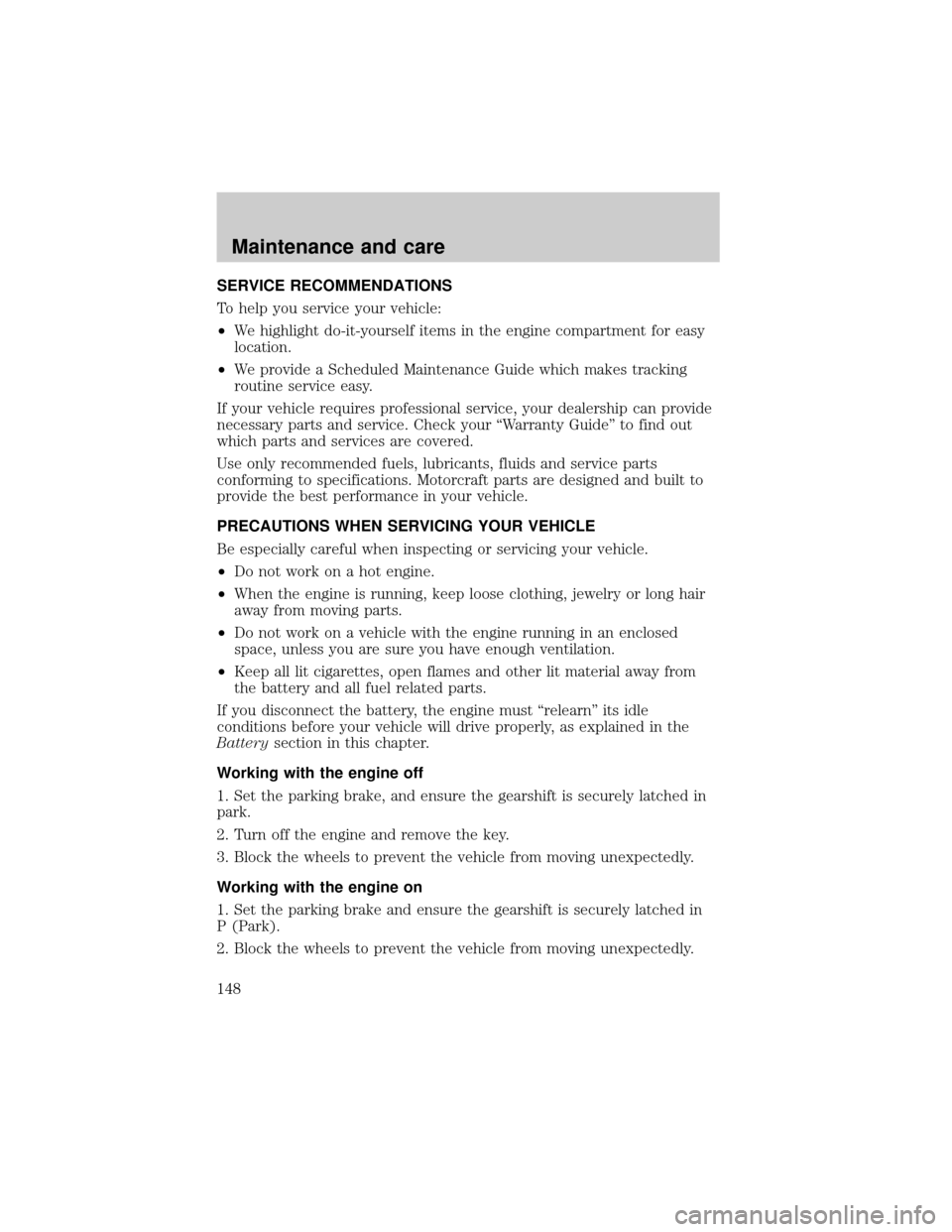
SERVICE RECOMMENDATIONS
To help you service your vehicle:
²We highlight do-it-yourself items in the engine compartment for easy
location.
²We provide a Scheduled Maintenance Guide which makes tracking
routine service easy.
If your vehicle requires professional service, your dealership can provide
necessary parts and service. Check your ªWarranty Guideº to find out
which parts and services are covered.
Use only recommended fuels, lubricants, fluids and service parts
conforming to specifications. Motorcraft parts are designed and built to
provide the best performance in your vehicle.
PRECAUTIONS WHEN SERVICING YOUR VEHICLE
Be especially careful when inspecting or servicing your vehicle.
²Do not work on a hot engine.
²When the engine is running, keep loose clothing, jewelry or long hair
away from moving parts.
²Do not work on a vehicle with the engine running in an enclosed
space, unless you are sure you have enough ventilation.
²Keep all lit cigarettes, open flames and other lit material away from
the battery and all fuel related parts.
If you disconnect the battery, the engine must ªrelearnº its idle
conditions before your vehicle will drive properly, as explained in the
Batterysection in this chapter.
Working with the engine off
1. Set the parking brake, and ensure the gearshift is securely latched in
park.
2. Turn off the engine and remove the key.
3. Block the wheels to prevent the vehicle from moving unexpectedly.
Working with the engine on
1. Set the parking brake and ensure the gearshift is securely latched in
P (Park).
2. Block the wheels to prevent the vehicle from moving unexpectedly.
Maintenance and care
148
Page 182 of 232
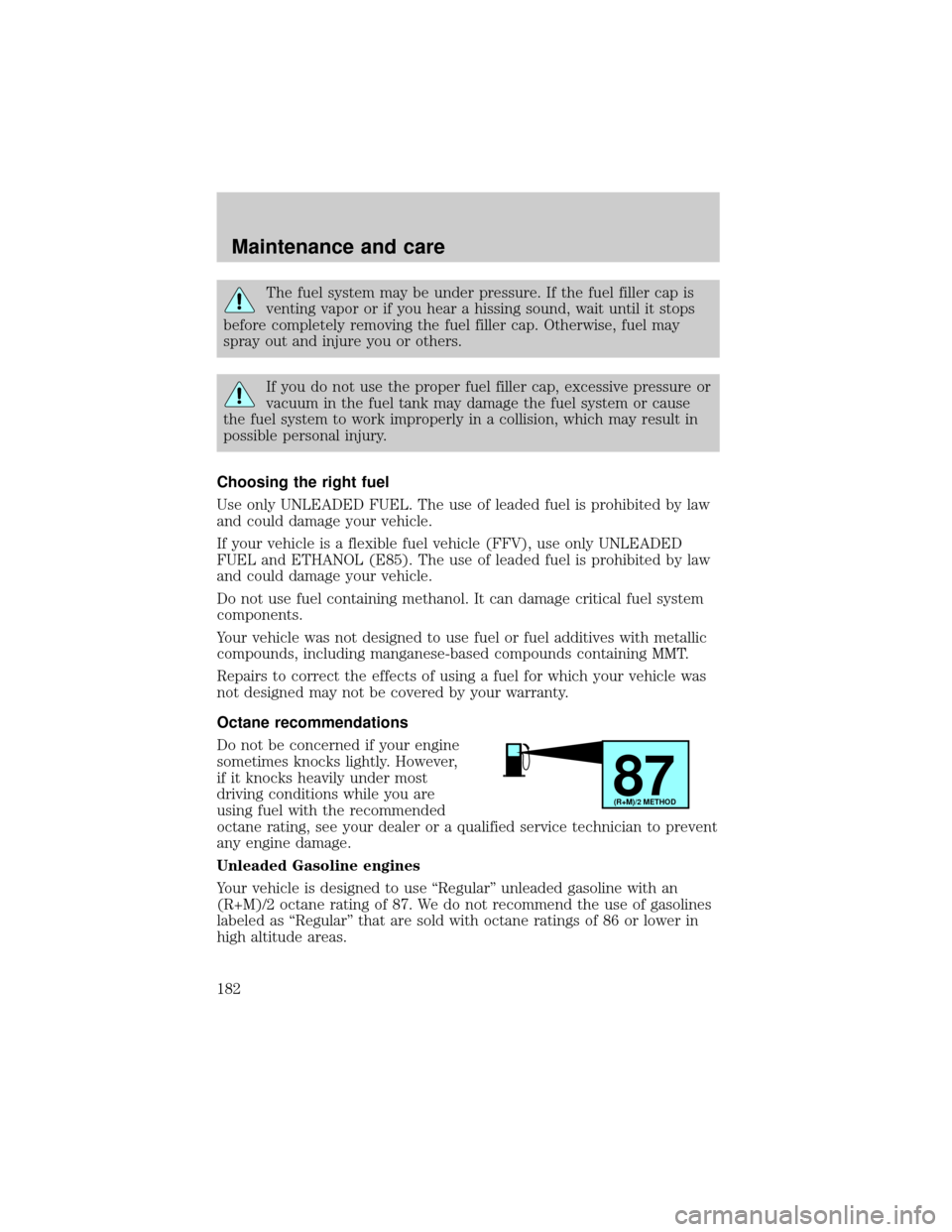
The fuel system may be under pressure. If the fuel filler cap is
venting vapor or if you hear a hissing sound, wait until it stops
before completely removing the fuel filler cap. Otherwise, fuel may
spray out and injure you or others.
If you do not use the proper fuel filler cap, excessive pressure or
vacuum in the fuel tank may damage the fuel system or cause
the fuel system to work improperly in a collision, which may result in
possible personal injury.
Choosing the right fuel
Use only UNLEADED FUEL. The use of leaded fuel is prohibited by law
and could damage your vehicle.
If your vehicle is a flexible fuel vehicle (FFV), use only UNLEADED
FUEL and ETHANOL (E85). The use of leaded fuel is prohibited by law
and could damage your vehicle.
Do not use fuel containing methanol. It can damage critical fuel system
components.
Your vehicle was not designed to use fuel or fuel additives with metallic
compounds, including manganese-based compounds containing MMT.
Repairs to correct the effects of using a fuel for which your vehicle was
not designed may not be covered by your warranty.
Octane recommendations
Do not be concerned if your engine
sometimes knocks lightly. However,
if it knocks heavily under most
driving conditions while you are
using fuel with the recommended
octane rating, see your dealer or a qualified service technician to prevent
any engine damage.
Unleaded Gasoline engines
Your vehicle is designed to use ªRegularº unleaded gasoline with an
(R+M)/2 octane rating of 87. We do not recommend the use of gasolines
labeled as ªRegularº that are sold with octane ratings of 86 or lower in
high altitude areas.
87(R+M)/2 METHOD
Maintenance and care
182
Page 186 of 232
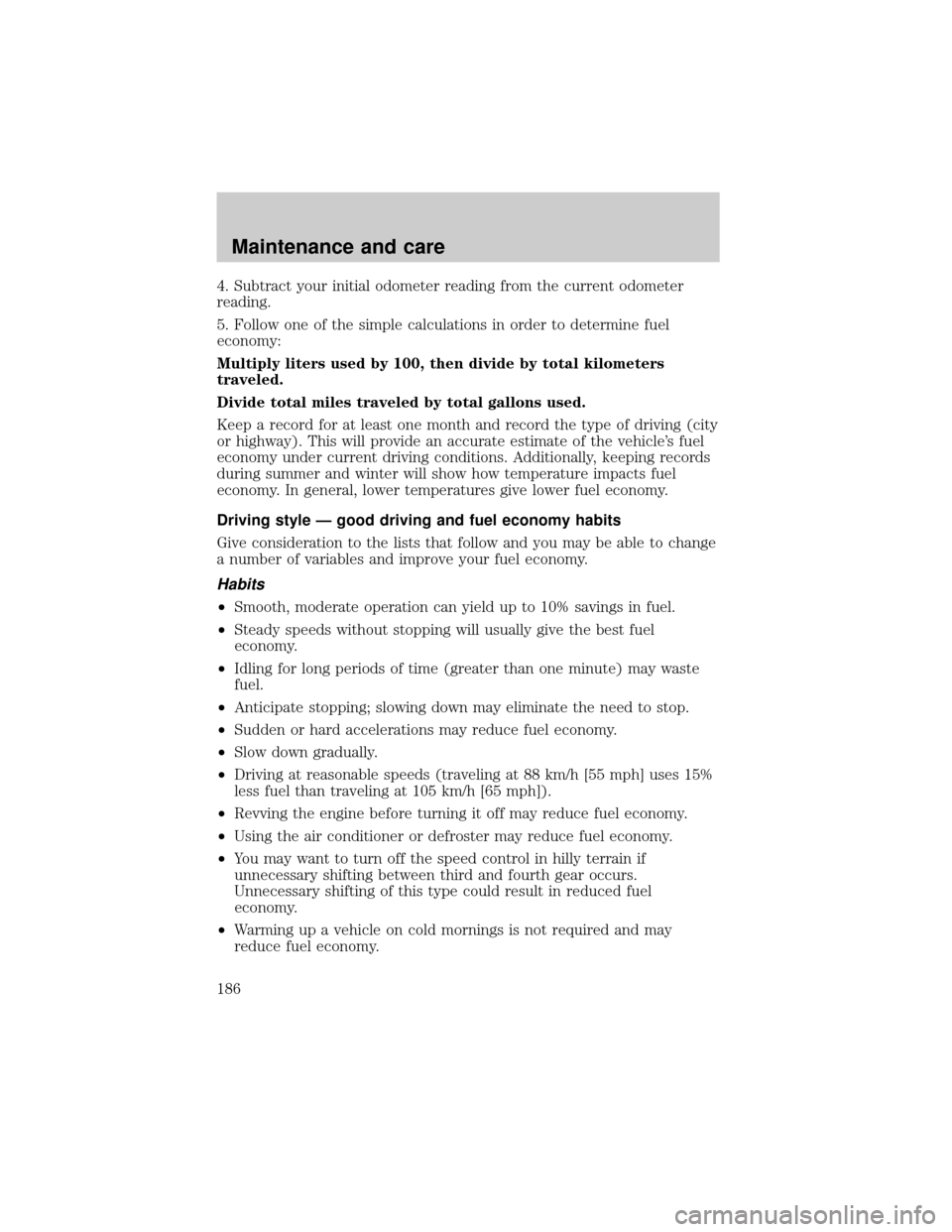
4. Subtract your initial odometer reading from the current odometer
reading.
5. Follow one of the simple calculations in order to determine fuel
economy:
Multiply liters used by 100, then divide by total kilometers
traveled.
Divide total miles traveled by total gallons used.
Keep a record for at least one month and record the type of driving (city
or highway). This will provide an accurate estimate of the vehicle's fuel
economy under current driving conditions. Additionally, keeping records
during summer and winter will show how temperature impacts fuel
economy. In general, lower temperatures give lower fuel economy.
Driving style Ð good driving and fuel economy habits
Give consideration to the lists that follow and you may be able to change
a number of variables and improve your fuel economy.
Habits
²Smooth, moderate operation can yield up to 10% savings in fuel.
²Steady speeds without stopping will usually give the best fuel
economy.
²Idling for long periods of time (greater than one minute) may waste
fuel.
²Anticipate stopping; slowing down may eliminate the need to stop.
²Sudden or hard accelerations may reduce fuel economy.
²Slow down gradually.
²Driving at reasonable speeds (traveling at 88 km/h [55 mph] uses 15%
less fuel than traveling at 105 km/h [65 mph]).
²Revving the engine before turning it off may reduce fuel economy.
²Using the air conditioner or defroster may reduce fuel economy.
²You may want to turn off the speed control in hilly terrain if
unnecessary shifting between third and fourth gear occurs.
Unnecessary shifting of this type could result in reduced fuel
economy.
²Warming up a vehicle on cold mornings is not required and may
reduce fuel economy.
Maintenance and care
186
Page 188 of 232
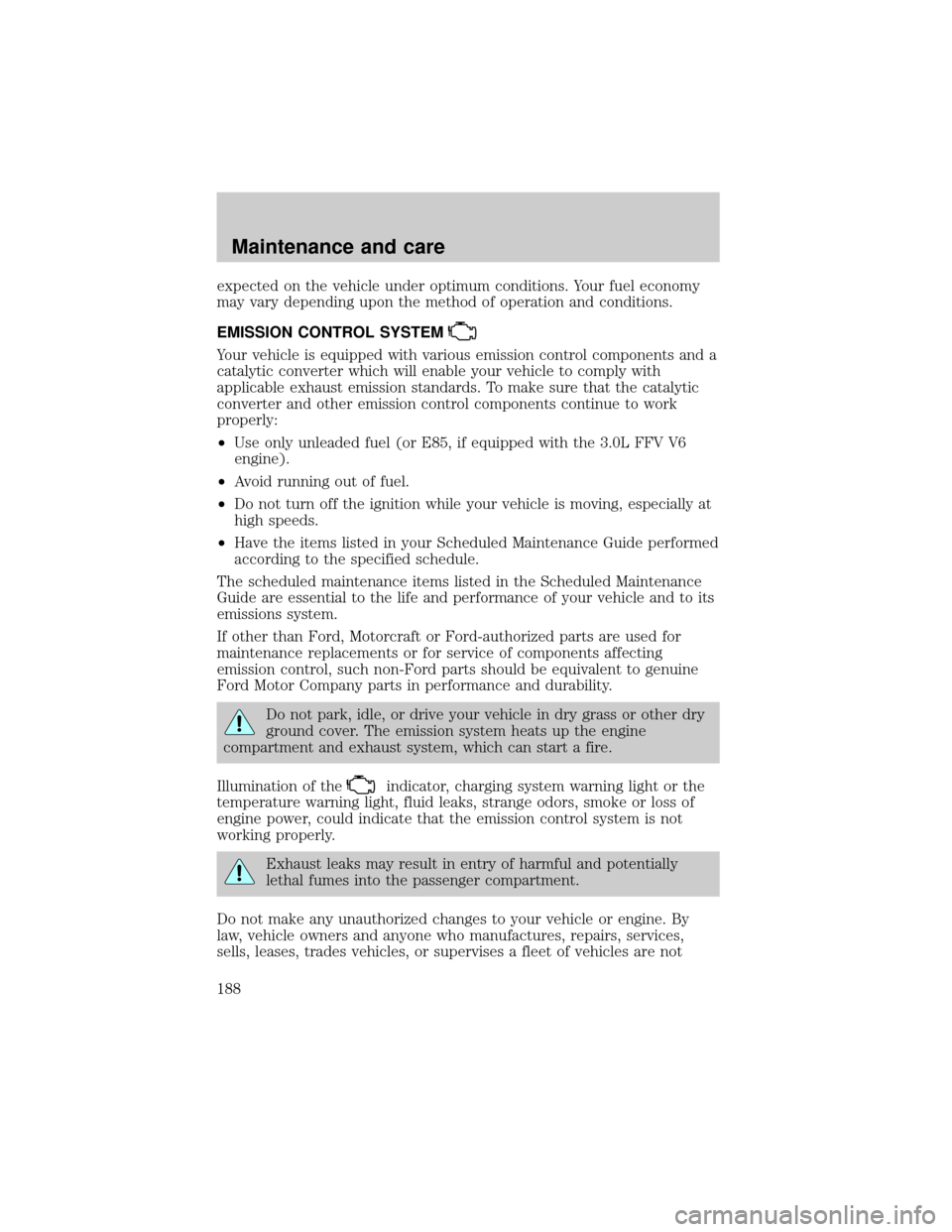
expected on the vehicle under optimum conditions. Your fuel economy
may vary depending upon the method of operation and conditions.
EMISSION CONTROL SYSTEM
Your vehicle is equipped with various emission control components and a
catalytic converter which will enable your vehicle to comply with
applicable exhaust emission standards. To make sure that the catalytic
converter and other emission control components continue to work
properly:
²Use only unleaded fuel (or E85, if equipped with the 3.0L FFV V6
engine).
²Avoid running out of fuel.
²Do not turn off the ignition while your vehicle is moving, especially at
high speeds.
²Have the items listed in your Scheduled Maintenance Guide performed
according to the specified schedule.
The scheduled maintenance items listed in the Scheduled Maintenance
Guide are essential to the life and performance of your vehicle and to its
emissions system.
If other than Ford, Motorcraft or Ford-authorized parts are used for
maintenance replacements or for service of components affecting
emission control, such non-Ford parts should be equivalent to genuine
Ford Motor Company parts in performance and durability.
Do not park, idle, or drive your vehicle in dry grass or other dry
ground cover. The emission system heats up the engine
compartment and exhaust system, which can start a fire.
Illumination of the
indicator, charging system warning light or the
temperature warning light, fluid leaks, strange odors, smoke or loss of
engine power, could indicate that the emission control system is not
working properly.
Exhaust leaks may result in entry of harmful and potentially
lethal fumes into the passenger compartment.
Do not make any unauthorized changes to your vehicle or engine. By
law, vehicle owners and anyone who manufactures, repairs, services,
sells, leases, trades vehicles, or supervises a fleet of vehicles are not
Maintenance and care
188
Page 219 of 232
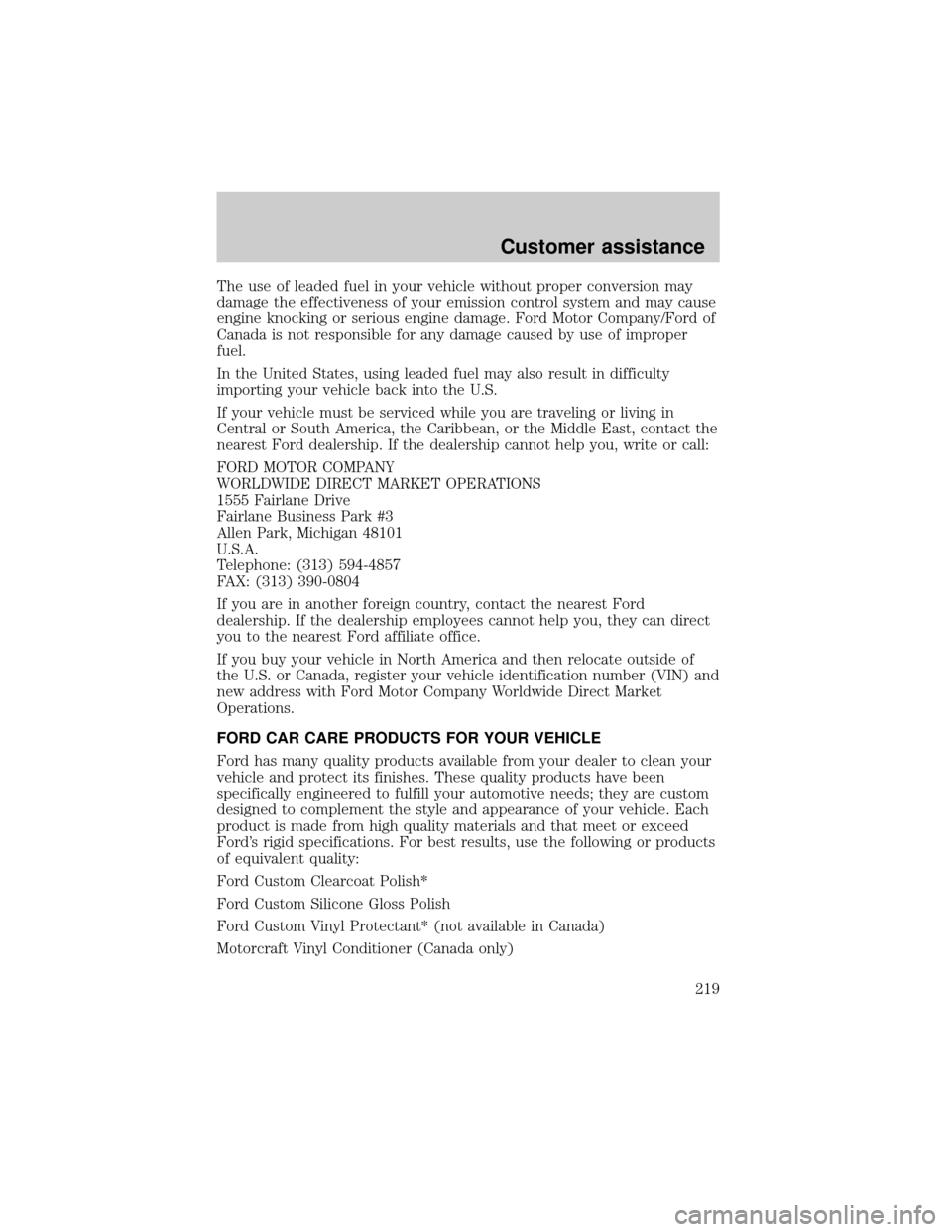
The use of leaded fuel in your vehicle without proper conversion may
damage the effectiveness of your emission control system and may cause
engine knocking or serious engine damage. Ford Motor Company/Ford of
Canada is not responsible for any damage caused by use of improper
fuel.
In the United States, using leaded fuel may also result in difficulty
importing your vehicle back into the U.S.
If your vehicle must be serviced while you are traveling or living in
Central or South America, the Caribbean, or the Middle East, contact the
nearest Ford dealership. If the dealership cannot help you, write or call:
FORD MOTOR COMPANY
WORLDWIDE DIRECT MARKET OPERATIONS
1555 Fairlane Drive
Fairlane Business Park #3
Allen Park, Michigan 48101
U.S.A.
Telephone: (313) 594-4857
FAX: (313) 390-0804
If you are in another foreign country, contact the nearest Ford
dealership. If the dealership employees cannot help you, they can direct
you to the nearest Ford affiliate office.
If you buy your vehicle in North America and then relocate outside of
the U.S. or Canada, register your vehicle identification number (VIN) and
new address with Ford Motor Company Worldwide Direct Market
Operations.
FORD CAR CARE PRODUCTS FOR YOUR VEHICLE
Ford has many quality products available from your dealer to clean your
vehicle and protect its finishes. These quality products have been
specifically engineered to fulfill your automotive needs; they are custom
designed to complement the style and appearance of your vehicle. Each
product is made from high quality materials and that meet or exceed
Ford's rigid specifications. For best results, use the following or products
of equivalent quality:
Ford Custom Clearcoat Polish*
Ford Custom Silicone Gloss Polish
Ford Custom Vinyl Protectant* (not available in Canada)
Motorcraft Vinyl Conditioner (Canada only)
Customer assistance
219
Page 221 of 232

Comfort and convenience
Air conditioner
Air filtration systems
Cargo nets
Cargo organizers
Cargo shades
Engine block heaters
Travel equipment
Auto headlamps with DRL
Daytime running lights (DRL)
Electrochromic inside mirror with compass
Electrochromic inside mirror with compass and temperature
Factory luggage rack adaptors
Framed luggage covers
Heavy-duty battery
Removable luggage rack
Removable luggage rack adapters
Soft luggage cover
Speed control
Track rider bars
Trailer hitch wiring adaptor
Protection and appearance equipment
Air bag anti-theft locks
Car/truck covers
Cargo liners, interior
Carpet floor mats
Cleaners, waxes and polishes
Flat splash guards
Front end covers (full)
Lubricants and oils
Customer assistance
221
Page 225 of 232

Accessory delay ..........................54
Air bag supplemental
restraint system ................94,95,98
and child safety seats ..............96
description ...........................95,98
disposal ....................................100
driver air bag ..................94,97,99
indicator light ......................12,97
operation .........................94,97,99
passenger air bag ...........94,97,99
side air bag ................................98
Air cleaner filter .......................205
Air conditioning ..........................18
automatic temperature
control system ..........................21
Air filter, cabin ..........................166
Antifreeze
(see Engine coolant) ................157
Anti-lock brake system
(see Brakes) .......................113,114
Anti-theft system ........................64
arming the system ....................64
disarming a triggered system ..66
warning light .............................11
Audio system (see Radio) .........28
Automatic transaxle .................118
driving with .............................120
fluid, adding ............................163
fluid, checking ........................163
fluid, refill capacities ..............206
fluid, specification ..................208
Auxiliary power point .................27
Axle
lubricant specifications ..........207
Battery .......................................171
acid, treating emergencies .....171
charging system
warning light .............................12
jumping a disabled battery ....142
maintenance-free ....................171
replacement, specifications ...205
servicing ..................................171Belt minder .................................90
Brakes ........................................113
anti-lock ............................113,114
anti-lock brake system
(ABS) warning light ..........11,114
brake warning light ..................12
fluid, checking and adding ....155
fluid, refill capacities ..............206
fluid, specifications ..........207,208
lubricant specifications ...207,208
parking ....................................115
pedals (see Power
adjustable foot pedals) ............43
shift interlock ..........................118
Break-in period .............................3
Capacities for refilling fluids ....206
Cargo area shade ........................59
Cargo cover .................................58
Cargo net .....................................58
CD changer .................................38
Cellular telephone
Wireless Interface Module .......51
Certification Label ....................210
Child safety restraints ..............101
child safety belts ....................101
Child safety seats ......................102
attaching with tether straps ..106
in front seat ............................103
in rear seat .......................103,106
Cleaning your vehicle ...............198
engine compartment ..............201
exterior ....................................200
exterior lamps .........................200
instrument panel ....................203
instrument panel lens ............203
interior ..............................203,204
mirrors .....................................200
plastic parts ............................200
safety belts ..............................203
washing ....................................199
waxing .....................................199
wheels ......................................200
Index
225
Page 226 of 232

windows ..................................203
wiper blades ............................201
woodtone trim ........................203
Climate control (see Air
conditioning or Heating) ............18
Clock .......................................31,38
Console ........................................56
Controls
power seat .................................75
Coolant
checking and adding ..............157
refill capacities .................161,206
specifications ...................207,208
Cruise control
(see Speed control) ....................44
Customer Assistance ................130
Ford accessories
for your vehicle ......................219
Ford Extended
Service Plan ............................212
Getting assistance outside
the U.S. and Canada ..............218
Getting roadside assistance ...130
Getting the
service you need ....................212
Ordering additional
owner's literature ...................223
The Dispute
Settlement Board ...................215
Utilizing the Mediation/
Arbitration Program ...............218
Daytime running lamps
(see Lamps) ................................16
Defrost
rear window ..............................17
Dipstick
automatic
transmission fluid ...................163
engine oil .................................152
Doors
door ajar warning .......................9
lubricant specifications ..........207Driving under special
conditions
through water .........................124
Emergencies, roadside
jump-starting ..........................142
Emission control system ..........188
Engine ........................................208
check engine/
service engine soon light ...........9
cleaning ...................................201
coolant .....................................157
idle speed control ...................171
lubrication
specifications ...................207,208
refill capacities ........................206
service points ...................150,151
starting after a collision .........131
Engine block heater .................111
Engine oil ..................................152
checking and adding ..............152
dipstick ....................................152
filter, specifications .........154,205
recommendations ...................154
refill capacities ........................206
specifications ...................207,208
Exhaust fumes ..........................112
Floor mats ...................................56
Fluid capacities .........................206
Fuel ............................................178
calculating fuel economy .......184
cap ...........................................181
capacity ...................................206
choosing the right fuel ...........182
comparisons with EPA fuel
economy estimates .................187
detergent in fuel .....................184
filling your vehicle
with fuel ....................178,181,185
filter, specifications .........184,205
fuel pump shut-off switch .....131
gauge .........................................15
improving fuel economy ........184
Index
226